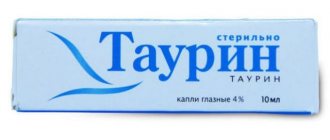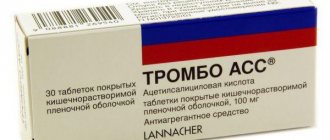pharmachologic effect
Aspirin is a non-steroidal anti-inflammatory drug, non-narcotic analgesic, and antiplatelet agent . This drug is known for its antipyretic, anti-inflammatory and analgesic effects, as well as its ability to reduce platelet aggregation. The active substance of Aspirin is acetylsalicylic acid, which is a derivative of salicylic acid, which in turn serves as the basis for many medicinal substances, the so-called salicylates.
The anti-inflammatory effect of Aspirin is due to the influence of acetylsalicylic acid on the processes occurring at the site of inflammation: it reduces capillary permeability, reduces the activity of hyaluronidase (a group of enzymes), and limits the energy supply of the inflammatory process by inhibiting the formation of the source of biochemical processes in living systems (ATP). Also, the use of Aspirin helps slow down the biosynthesis of a group of physiologically active substances, the so-called prostaglandins. The ability of acetylsalicylic acid to have an antipyretic effect is explained by its effect on the hypothalamic centers of thermal regulation. The analgesic effect of Aspirin is due to the effect of the drug on pain sensitivity centers. The ability of the drug to reduce intracranial pressure during headaches is explained by its blood-thinning effect.
General information about the drug
- tablets 0.1, 0.25 and 0.5 grams;
- tablets are packaged in contour cell-free or contour cell packaging No. 10x1, No. 10x2, No. 10x3.
ASA is part of the pharmacological group of non-steroidal anti-inflammatory drugs (LPs). INN – acetylsalicylic acid. Provides antipyretic, anti-inflammatory and analgesic effects of the drug. It is used to eliminate pain syndromes of varying degrees, normalize body temperature, which increases with colds, neuralgia, and can act as an antirheumatic drug.
Difference from Aspirin
This drug is well known to everyone. However, the question often arises: is ASA Aspirin or not? Both drugs are based on the same active ingredient. In addition, they have a similar effect on the human body. That is, we can say that these are complete synonyms.
Mechanism of action of ASA
ASA is a medical substance that is widely used in the fields of therapy, surgery and cardiology. Aspirin is the trade name for ASA. The only difference between them is the dosage. According to the instructions, ASA is available in 500 or 250 mg doses, and Aspirin is available in 300, 100, 500 mg doses. Otherwise, these drugs are absolutely identical.
The medication is supplied to Russian pharmacies in the form of tablets packaged in cellless/cell contour tablets (No. 10x3, No. 10x2, No. 10x1). The cost of the drug ranges from 4-20 rubles, depending on the dosage. The price of Aspirin is indicated in the table in rubles and may differ depending on the pricing policy of a particular pharmacy.
Release form
Aspirin is available in the form of tablets of 500 mg and 100 mg, effervescent tablets of 350 mg, enteric-coated tablets of 300 mg, 100 mg and 50 mg..
Aspirin coated tablets are more resistant to the action of gastric juice than the drug in the form of conventional tablets, and also significantly reduce the frequency of negative effects from the stomach. Sodium bicarbonate, which is part of Aspirin effervescent tablets, acts as a neutralizer of free hydrochloric acid in the stomach, which reduces the irritation that acetylsalicylic acid has on the mucous membranes of the gastrointestinal tract. Effervescent tablets are taken after meals, previously dissolved in a glass of water.
Drug interactions
- Increases the toxicity of methotrexate, the effect of narcotic analgesics, other NSAIDs, hypoglycemic agents for oral administration, heparin, indirect anticoagulants, thrombolytics - platelet aggregation inhibitors, sulfonamides, triiodothyrokine. Aspirin reduces the effect of uricosuric drugs (benzbromarone, probenecid), antihypertensive drugs and diuretics (spironolactone, furosemide).
- The damaging effect on the gastrointestinal mucosa is increased by glucocorticosteroids, alcohol and ethanol-containing drugs. This combination increases the risk of developing gastrointestinal bleeding.
- Increases the concentration of digoxin, barbiturates and lithium drugs in the blood plasma.
- The elimination of Aspirin is slowed down by antacids containing magnesium or aluminum hydroxide.
Indications for use of Aspirin
Prescribing the drug is advisable in the following cases:
- acute migraine attack;
- rheumatic diseases;
- fever accompanying infectious and inflammatory diseases;
- pain syndrome of various origins, expressed in weak or strong form;
- transient ischemic disorders of cerebral circulation (prevention and treatment);
- prevention of myocardial infarction (mainly in patients with unstable angina);
- prevention of embolism and thrombosis;
- secondary prevention of myocardial infarction.
Which is better Paracetamol or Aspirin
The drugs are sold without a prescription, but before using the drugs it is recommended to consult with your doctor. The specialist will select a medicine depending on the severity of the disease, the individual characteristics of the patient and the presence of contraindications. When self-medicating, the tablets must be taken strictly according to the attached instructions so as not to harm the body.
For fungal diseases
Both medications do not have fungicidal properties and therefore are not able to eliminate fungal infections. Aspirin and Paracetamol can be taken together with antifungal drugs as an anti-inflammatory and pain reliever. Before taking medications, you should consult your doctor.
For a cold
For viral diseases accompanied by high fever and inflammation, Paracetamol is more effective. To achieve an antipyretic effect, you should take 1 tablet every 2-3 hours. For adult patients and children over 12 years of age, the medicine can be replaced with Aspirin.
For headaches
For mild to moderate headaches, you should take Aspirin. Paracetamol does not have a pronounced analgesic effect. Adult patients should take 1 tablet of acetylsalicylic acid.
The medicine should be taken with alkaline liquids to minimize the effect of Aspirin on the mucous membranes of the stomach.
For a hangover
Paracetamol is not effective against hangover symptoms. For severe headaches, taking 2 Aspirin tablets will help. The therapeutic effect will last 1-3 hours, which is due to the high concentration of ethanol in the blood. Alcohol reduces the analgesic effect of the drug. It is important to remember that the medicine will create a strong load on the liver cells. Hepatocytes do not have time to neutralize and remove ethyl alcohol.
The medications will not help get rid of nausea or dry mouth.
How to use Aspirin
A single dose of the drug can be used three times a day, the interval between doses should be within 4-8 hours. Patients with impaired liver and kidney function must either increase the interval between doses or reduce the dose.
According to the instructions for Aspirin, the dose of the drug depends on the purpose of use:
- for fever, pain, rheumatic diseases for children over 5 years old, a single dose is 0.25-0.75 g (no more than 1.5 g per day); a single dose for adults should not exceed 1 g, and a daily dose – 3 g;
- for secondary prevention of myocardium and unstable angina, the daily dose should be in the range of 300-325 mg;
- for a migraine attack, a single dose is 1 g (no more than 3 g per day);
- for cerebrovascular accidents, Aspirin is prescribed in a dose not exceeding 300 mg per day.
The tablets should be taken before meals, swallowed whole with water, or dissolved in water. The use of Aspirin for more than three days without a doctor's prescription is strictly prohibited.
Side effects
How to take aspirin can be found in the instructions for use. Most often, the medicine is used up to 3 times a day, one tablet per dose. But don’t forget - like any other medicine, this one also has its contraindications.
- An allergic reaction, which most often manifests itself as aspirin asthma.
- Stomach ache.
- Decrease in the total number of platelets in the blood.
- Bleeding in the stomach.
- General weakness.
- Anemia.
It is better to take acetyl only as prescribed by a doctor. Many people start using these pills with or without reason, but this should not be done. The use of this remedy must be justified.
Contraindications
The instructions for Aspirin indicate a number of diseases for which the use of the drug is unacceptable:
- bronchial asthma provoked by taking salicylates and non-steroidal anti-inflammatory drugs;
- erosive and ulcerative diseases of the gastrointestinal tract;
- simultaneous use of Aspirin with methotrexate with a weekly dose of 15 mg;
- hemorrhagic diathesis;
- liver and kidney failure;
- angina pectoris;
- arterial hypertension;
- decompensation of severe heart failure;
- enlargement of the thyroid gland.
Aspirin is not prescribed in the first and third trimesters of pregnancy, lactation, children under 15 years of age in whom viral infections have provoked acute respiratory diseases, as well as persons with hypersensitivity to salicylates.
Some caution is necessary when prescribing Aspirin to patients suffering from:
- gout, hyperuricemia;
- ulcerative lesions of the gastrointestinal tract or gastrointestinal bleeding;
- dysfunction of the liver and kidneys;
— chronic respiratory diseases;
- bronchial asthma;
- hay fever;
- polyposis of the nasal mucosa;
- allergic reactions to medications.
The second trimester of pregnancy is also a reason for preliminary consultation with a doctor before using Aspirin.
Use during pregnancy and lactation
Some retrospective epidemiological studies have shown that the use of ASA in the first trimester of pregnancy increases the risk of developing birth defects (including cleft palate and heart defects). However, the results of other studies, which involved 32,000 mother-child pairs, suggest that taking Aspirin in therapeutic doses not exceeding 150 mg per day does not increase the incidence of congenital malformations. Since research results are controversial, the use of Aspirin in the first trimester of pregnancy is not recommended. When taken in the second trimester of pregnancy, care must be taken; the drug can be prescribed only after a thorough assessment of the balance between the benefits of treatment for the mother and the risks for the child. In the case of a long course of therapy, the daily dose of ASA should not exceed 150 mg.
In the third trimester, taking Aspirin in high doses (more than 300 mg per day) can lead to post-term pregnancy and weakening of labor, as well as premature closure of the ductus arteriosus (ductus arteriosus) in the child. Taking ASA in significant doses shortly before birth sometimes leads to the development of intracranial bleeding, especially in premature infants. In this regard, the use of Aspirin in the last trimester of pregnancy is contraindicated, with the exception of special cases due to cardiac and obstetric indications using special monitoring.
If it is necessary to use Aspirin during lactation, it is recommended to stop breastfeeding.
Aspirin Cardio
The release form of Aspirin Cardio is enteric-coated tablets, 100 mg and 300 mg.
According to the instructions, Aspirin Cardio is used for all diseases that are accompanied by the risk of occurrence or the presence of excessive thrombus formation. This drug is advisable to use in the treatment and prevention of all forms of coronary heart disease, myocardial infarction, stable and unstable angina, vascular and heart surgery.
The instructions for Aspirin Cardio indicate the following dosage regimen: the daily dose (from 0.1 to 0.3 g) is taken once every one or two days. The course of treatment with Aspirin Cardio is usually long and is determined by the doctor individually for each patient.
Since the active ingredient of this drug is acetylsalicylic acid, the pharmacological actions, indications and contraindications for use, as well as side effects indicated in the instructions for Aspirin Cardio are similar to the identical characteristics of Aspirin.
Overdose
A moderate overdose of Aspirin is manifested by symptoms such as clouding of consciousness, headache, dizziness, nausea, vomiting, hearing loss, and tinnitus. In most cases, they disappear when the dose of the drug is reduced.
Severe overdose of the drug is characterized by such manifestations as severe hypoglycemia, respiratory failure, hyperventilation, fever, cardiogenic shock, respiratory alkalosis, ketosis, metabolic acidosis, coma.
If Aspirin is taken in very high doses, the patient is hospitalized. It is recommended to take activated charcoal and constantly monitor the acid-base balance, as well as alkaline diuresis, which is carried out until the urine pH is in the range of 7.5–8 [forced alkaline diuresis is considered effective if, as a result of the procedure, the content of salicylate in the blood exceeds 500 mg/l (3.6 mmol/l) in adult patients and 300 mg/l (2.2 mmol/l) in children]. If necessary, lavage and hemodialysis sessions are performed. Treatment measures also include symptomatic treatment and replacement of fluid deficiency.
How to take it for children?
It is recommended to give Aspirin to children from the age of 12.
It is prohibited to give drugs containing ASA to children with a fever that rises due to a viral infection, since ASA acts on the same structures of the liver and brain as some viruses.
Thus, the combination of Aspirin and a viral infection can cause the development of Reye's syndrome, a disease that affects the brain and liver and from which approximately one in five young patients die.
Read also: What is Diclofenac prescribed for? Instructions, reviews and analogues, price in pharmacies
The risk of developing Reye's syndrome is increased in cases where ASA is used as a concomitant medication, but there is no evidence of a cause-and-effect relationship in such cases. One of the signs of Reye's syndrome is prolonged vomiting.
As a single dose, children under three years old are usually given 100 mg, children four to six years old - 200 mg, and children seven to nine years old - 300 mg ASA.
The recommended dose for a child is 60 mg/kg/day, divided into 4-6 doses, or 15 mg/kg every 6 hours or 10 mg/kg every 4 hours. The drug in this dosage form is not used in children under three years of age.
Can I take Aspirin with alcohol?
Aspirin and alcohol are incompatible. There are descriptions of cases where taking even 40 g of alcohol in combination with the drug was accompanied by the development of gastric bleeding and severe allergic reactions.
Does Aspirin help with hangovers?
Aspirin for a hangover is very effective due to the ability of ASA to prevent platelet aggregation (both spontaneous and induced).
When asked whether it is possible to drink Aspirin with a hangover, doctors answer that it is better to take the drug not after alcohol, but about 2 hours before the planned feast. This will prevent microthrombi in the small blood vessels of the brain and, to some extent, tissue swelling.
When you have a hangover, it is best to take quickly dissolving Aspirin, for example, Upsarin UPSA. The latter is less irritating to the gastrointestinal mucosa, and the citric acid it contains activates the processing of under-oxidized alcohol breakdown products. The optimal dosage is 500 mg for every 35 kg of body weight.
Analogs
- Anopyrine;
- ASK-cardio;
- Aspicor;
- Aspinat;
- Aspirin 1000;
- Aspirin Cardio;
- Acecardole;
- Acenterine;
- Acetylsalicylic acid;
- Acetylsalicylic acid Cardio;
- Acylpyrine;
- Acsbirin;
- Bufferin;
- Zorex Morning;
- CardiASK;
- Colfaritis;
- Mikristin;
- Taspir;
- Thrombo ACC;
- Thrombopol;
- Walsh-asalgin;
- Upsarin UPSA.
When choosing analogues, you must remember that the instructions for use of Aspirin, price and reviews do not apply to drugs of similar effect. Replacing the drug is permissible only after the recommendation of a doctor.
Which is better: Aspirin or Aspirin Cardio?
When asked what is the difference between Aspirin and Aspirin Cardio, doctors answer that the differences between the drugs are the dosage of the active substance (lower in Aspirin Cardio) and the fact that Aspirin Cardio tablets are produced in a special enteric coating, which protects the mucous membrane of the digestive canal from the aggressive action of ASA.
Aspirin and Aspirin Cardio have different indications for use. The first (it contains 500 mg of ASA) is used as an analgesic, antipyretic and anti-inflammatory agent, Aspirin Cardio, the concentration of ASA in which is 100 or 300 mg/tablet, is prescribed for the prevention and treatment of:
thrombosis and embolism after CABG, transdermal intravascular coronary angioplasty and other vascular operations;
- myocardial infarction;
- unstable angina;
- passing disturbances of blood flow in the brain and stroke at the premorbid stage;
- coronary artery thrombosis in patients at risk;
- migraine (including for long-term prevention).








